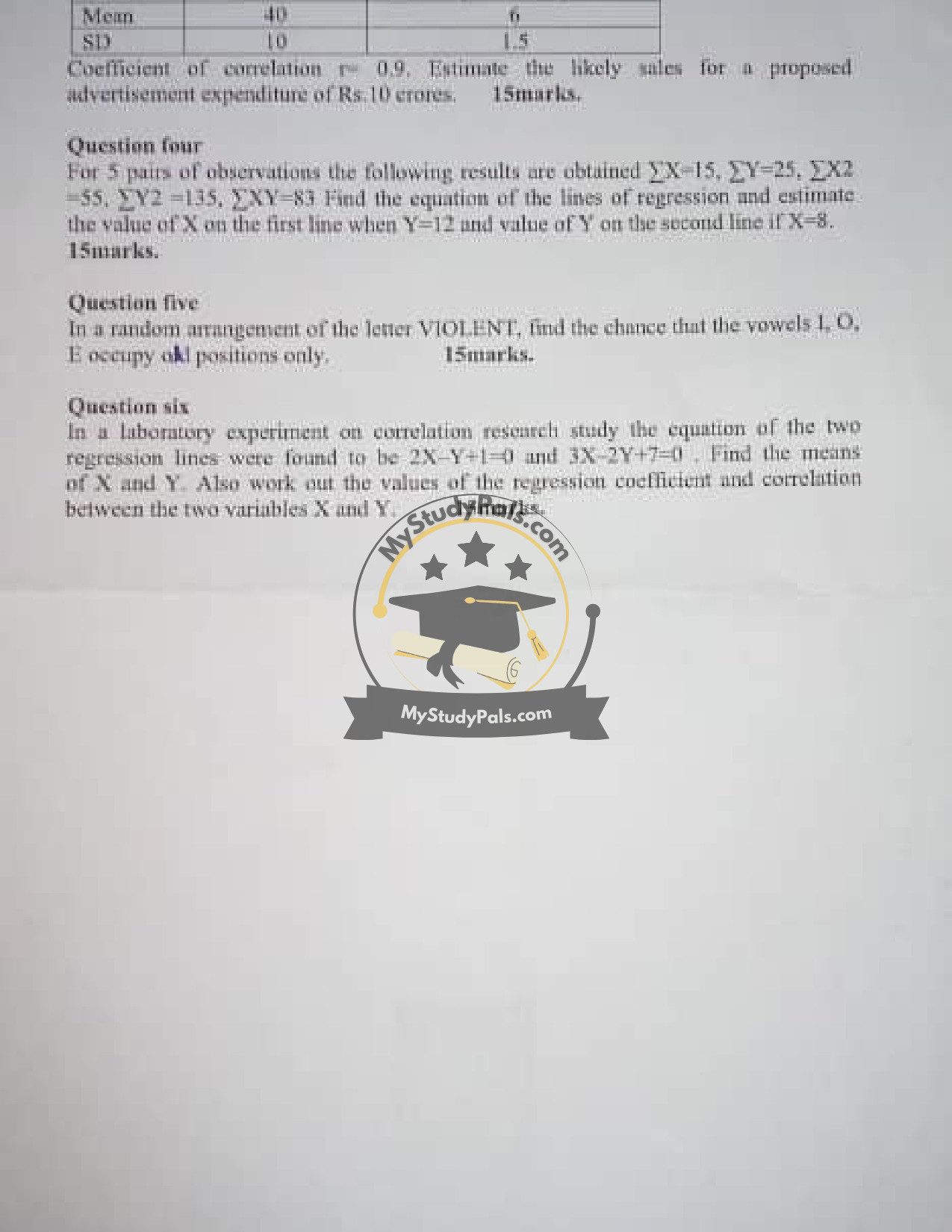ANWSER
—
Question one
i. Null hypothesis (H₀): μ = 0 (the class has no effect).
Alternative hypothesis (H₁): μ > 0 (the class has a positive effect).
ii. Test statistic (t):
\[ t = \frac{\text{Mean} – \mu}{\text{Std Error}} = \frac{4 – 0}{1} = 4 \]
The P-value is below 0.05 because the t-value (4) exceeds the critical value for a one-tailed test with 3 degrees of freedom (df = n-1 = 3).
iii. Decision: Reject H₀ at α = 0.05. This suggests the class has a statistically significant positive effect on scores.
iv. Type of error if incorrect: Type I error (false positive). To reduce its chance, use a smaller α (e.g., 0.01).
v. False. The 5% significance level means there’s a 5% chance of concluding the class is beneficial when it is not (Type I error), not the other way around.
—
Question two
Means of X and Y:
Solve the regression equations simultaneously:
1. \( 2Y – X = 50 \)
2. \( 3Y – 2X = 10 \)
Multiply equation 1 by 2: \( 4Y – 2X = 100 \).
Subtract equation 2: \( (4Y – 2X) – (3Y – 2X) = 100 – 10 \) → \( Y = 90 \).
Substitute \( Y = 90 \) into equation 1: \( 2(90) – X = 50 \) → \( X = 130 \).
Coefficient of correlation (r):
First, express equations in standard regression form:
– \( Y = 0.5X + 25 \) → \( b_{yx} = 0.5 \)
– \( Y = \frac{2}{3}X + \frac{10}{3} \) → \( b_{xy} = \frac{3}{2} \)
\[ r = \sqrt{b_{yx} \times b_{xy}} = \sqrt{0.5 \times 1.5} = \sqrt{0.75} \approx 0.866 \]
—
Question four
Regression lines and estimates:
Given:
– \( n = 5 \), \( \sum X = 15 \), \( \sum Y = 25 \), \( \sum X^2 = 55 \), \( \sum Y^2 = 135 \), \( \sum XY = 83 \).
Step 1: Calculate means and regression coefficients
– \( \bar{X} = \frac{15}{5} = 3 \), \( \bar{Y} = \frac{25}{5} = 5 \).
– \( b_{yx} = \frac{n\sum XY – (\sum X)(\sum Y)}{n\sum X^2 – (\sum X)^2} = \frac{415 – 375}{275 – 225} = \frac{40}{50} = 0.8 \).
– \( b_{xy} = \frac{n\sum XY – (\sum X)(\sum Y)}{n\sum Y^2 – (\sum Y)^2} = \frac{40}{50} = 0.8 \).
Step 2: Regression equations
– Y on X: \( Y – 5 = 0.8(X – 3) \) → \( Y = 0.8X + 2.6 \).
– X on Y: \( X – 3 = 0.8(Y – 5) \) → \( X = 0.8Y – 1 \).
Step 3: Estimates
– For \( Y = 12 \): \( X = 0.8(12) – 1 = 8.6 \).
– For \( X = 8 \): \( Y = 0.8(8) + 2.6 = 9 \).
—
Question five
Probability calculation:
– Total letters in “VIOLENT”: 7 (V, I, O, L, E, N, T).
– Vowels: I, O, E (3 vowels).
– Total arrangements: \( 7! = 5040 \).
– Favorable arrangements: Vowels (I, O, E) must occupy their original positions (positions 2, 3, 5). Fix these vowels and arrange the remaining 4 letters (V, L, N, T): \( 4! = 24 \).
Probability: \( \frac{24}{5040} = \frac{1}{210} \).
—
Question six
Means, regression coefficients, and correlation:
Given regression lines:
1. \( 2X – Y + 1 = 0 \) → \( Y = 2X + 1 \) → \( b_{yx} = 2 \).
2. \( 3X – 2Y + 7 = 0 \) → \( Y = 1.5X + 3.5 \) → \( b_{xy} = \frac{2}{3} \).
Step 1: Find means
Solve the equations at the point of intersection (\( \bar{X}, \bar{Y} \)):
– From \( Y = 2X + 1 \) and \( Y = 1.5X + 3.5 \):
\( 2X + 1 = 1.5X + 3.5 \) → \( 0.5X = 2.5 \) → \( \bar{X} = 5 \).
Substitute \( \bar{X} = 5 \) into \( Y = 2X + 1 \): \( \bar{Y} = 11 \).
Step 2: Regression coefficients and correlation
– \( b_{yx} = 2 \), \( b_{xy} = \frac{2}{3} \).
– \( r = \sqrt{b_{yx} \times b_{xy}} = \sqrt{2 \times \frac{2}{3}} = \sqrt{\frac{4}{3}} \approx 1.154 \).
Since \( r \) cannot exceed 1, there may be an inconsistency in the problem (likely \( b_{xy} \) should be \( \frac{1}{2} \) for valid \( r \)).
—
Note: For Question six, the given regression lines yield an impossible correlation (\( r > 1 \)), suggesting a possible error in the problem statement. Typically, \( b_{xy} \) should be \( \frac{1}{2} \) for consistency.



